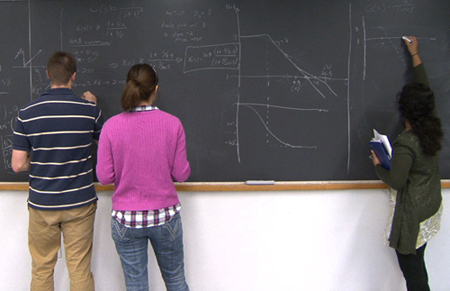In this section, Prof. Steven Hall offers a few tips he uses to accommodate for active learning in his classroom.

The ample blackboard space in the recitation classroom allows students to work simultaneously around the room. (Image courtesy of MIT OpenCourseWare.)
For some teaching techniques, the architecture of the room is important, so the instructor needs to think about what room is appropriate and get that kind of room if possible. In a classroom where you use peer instructions or concept questions, a room that is steeply tiered or long and narrow is awkward because it’s hard for the professor to walk around to groups in the back.
When I teach this stand-up recitation, it’s important the students have room to work. Recitations typically have 20 to 25 students. That means we have 10 to 12 pairs of students working, so we need 10 to 12 workstations. A great classroom would have boards filling two or three walls all around the room, but most classrooms at MIT don’t have quite enough blackboard space for that to work. What we typically do is put poster-size Post-It notes up on the bare walls around the room and use markers, and that usually provides enough space for the students to work. One strategy with the Post-It notes is to give students different colored markers. So if Sally is working in red and Bob is working in blue, you can tell which student has written which component of the answer.










